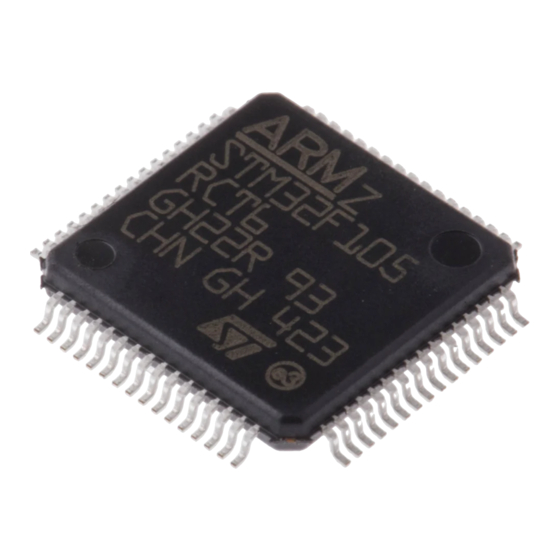
ST STM32F105 series Manuals
Manuals and User Guides for ST STM32F105 series. We have 3 ST STM32F105 series manuals available for free PDF download: Reference Manual, Application Note
ST STM32F105 series Reference Manual (1128 pages)
advanced ARM-based 32-bit MCUs
Brand: ST
|
Category: Controller
|
Size: 11 MB
Table of Contents
-
-
Memory Map51
-
Bit Banding54
-
-
-
-
-
-
Reset123
-
Clocks125
-
RCC Registers132
-
RCC Register Map156
-
-
-
-
Table 24. Usarts167
-
Table 25. SPI167
-
Table 26. I2S168
-
Table 27. I2C168
-
Table 28. Bxcan168
-
Table 29. USB168
-
Table 31. SDIO169
-
Table 32. FSMC169
-
GPIO Registers171
-
-
AFIO Registers183
-
-
-
EXTI Registers210
-
-
ADC Introduction214
-
-
ADC Clock218
-
Timing Diagram219
-
Analog Watchdog220
-
Scan Mode220
-
Calibration222
-
Data Alignment223
-
DMA Request226
-
Dual ADC Mode227
-
Independent Mode232
-
ADC Interrupts235
-
ADC Registers236
-
-
-
DAC Introduction253
-
-
DAC Data Format255
-
DAC Conversion256
-
DMA Request258
-
Noise Generation258
-
-
DAC Registers264
-
-
(Dac_Dhr12R1)268
-
-
-
(Dac_Dhr12L1)268
-
-
-
(Dac_Dhr8R1)268
-
-
-
(Dac_Dhr12R2)269
-
-
-
(Dac_Dhr12L2)269
-
-
-
(Dac_Dhr8R2)269
-
-
-
(Dac_Dhr12Ld)270
-
-
-
(Dac_Dhr8Rd)271
-
-
DAC Register Map272
-
-
-
DMA Introduction273
-
-
DMA Transactions275
-
Arbiter276
-
DMA Channels276
-
Error Management279
-
Interrupts280
-
-
DMA Registers284
-
DMA Register Map289
-
-
-
-
Time-Base Unit295
-
Counter Modes296
-
Clock Selection306
-
PWM Input Mode311
-
PWM Mode314
-
One-Pulse Mode323
-
Debug Mode332
-
-
-
Break Feature350
-
-
-
Time-Base Unit362
-
Counter Modes364
-
Clock Selection372
-
PWM Input Mode378
-
PWM Mode380
-
One-Pulse Mode383
-
Debug Mode396
-
-
-
-
-
Time-Base Unit421
-
Counter Modes422
-
Clock Selection425
-
-
PWM Mode432
-
One-Pulse Mode433
-
Debug Mode437
-
-
-
-
(Timx_Ccmr1)454
-
-
-
-
Time-Base Unit462
-
Counting Mode464
-
Clock Source466
-
Debug Mode467
-
-
-
-
RTC Introduction473
-
-
Overview475
-
-
RTC Registers478
-
RTC Register Map484
-
-
-
IWDG Registers487
-
-
Debug Mode494
-
WWDG Registers495
Advertisement
ST STM32F105 series Application Note (83 pages)
System memory boot mode
Brand: ST
|
Category: Microcontrollers
|
Size: 1 MB
Table of Contents
-
-
Get Command15
-
Go Command23
ST STM32F105 series Application Note (29 pages)
Brand: ST
|
Category: Computer Hardware
|
Size: 0 MB
Table of Contents
-
System Reset10
-
Clocks12
-
Introduction18
Advertisement
Advertisement


